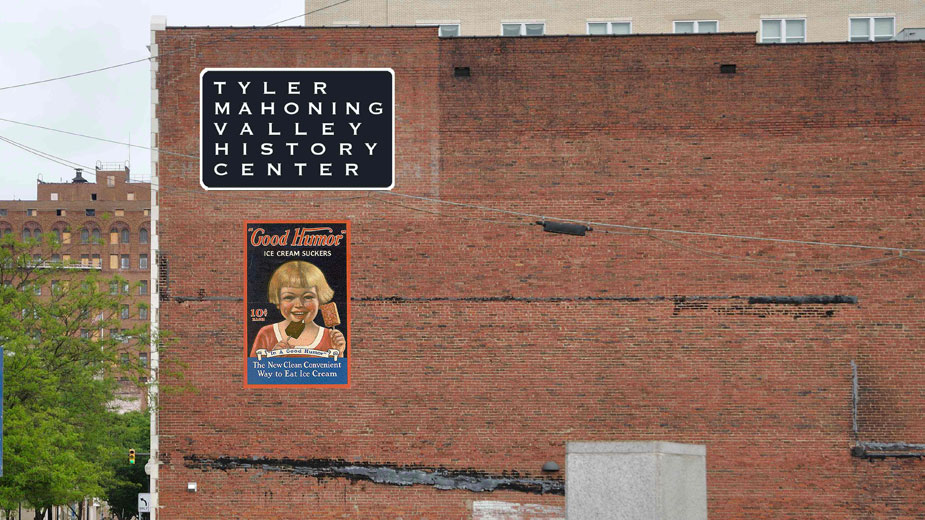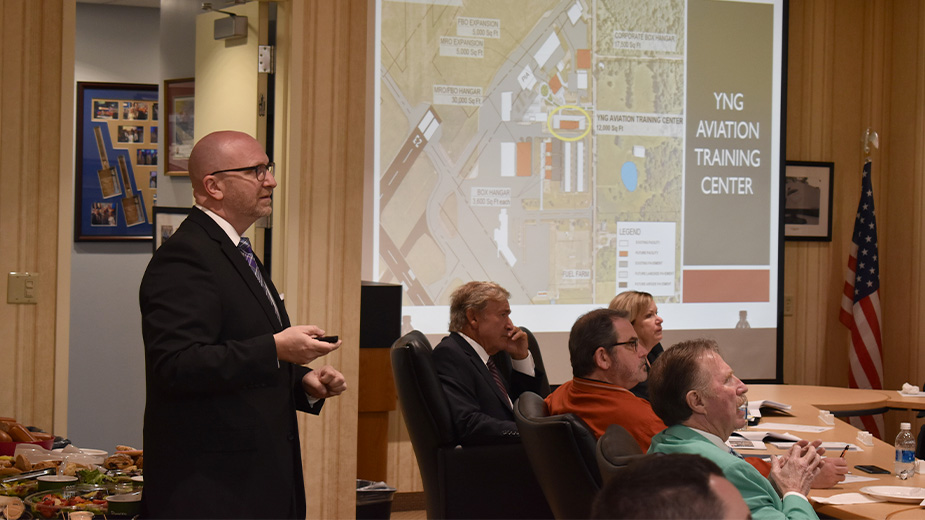Old Ad Sign, New Banners Going Up Downtown
YOUNGSTOWN, Ohio – The Mahoning Valley Historical Society wants to bring back a decorative feature from days of yore – painted advertising signage on the sides of downtown buildings.
The city’s design review committee approved the society’s request for signage for the Tyler Mahoning Valley History Center downtown, including a reproduction of a historic Good Humor ice cream sign. The Tyler Center is in the downtown building where Harry Burt made and sold his Good Humor ice cream bars.
The request, presented by the society’s executive director, Bill Lawson, was among several items the committee acted on during its monthly meeting Tuesday. Others included a request for banner signage for the 16 Wick Building, which a representative of NYO Property Group said the company eventually intends to develop as apartments.
“As we know, painted-on commercial signs were a big part of downtown’s history, until neon and billboards took over that part of it,” Lawson told the committee. “What we want to do on this west side [of the building] is recreate that craft in providing signage for the Tyler Mahoning Valley History Center.”
The sign is a reproduction of a 1920s Good Humor advertising piece from the MVHS collection that appeared in magazines and other forms of advertising, he said. The society has an agreement with artist Christian Mrosko to paint the reproduction on the building for $7,500.
Mrosko’s other works include the “Welcome to Youngstown” mural drivers see as they enter the downtown on Market Street and the mural next to the Youngstown Playhouse on the South Side. “He’s saying that the life of this will probably be about 15 years,” Lawson said.
“You walk around town and you see all the faded signs that were here. It really is appropriate to go back and do this,” said local architect Paul Ricciuti, who accompanied Lawson.
The committee also approved NYO’s request to hang two vinyl banners on the two sides of the elevator shaft at 16 Wick for six months, but the approval was conditioned on the downtown developer removing two existing banners it has on two other properties it owns, Erie Terminal Place, where it leases apartments, and the vacant Legal Arts Building.
The purpose of the banners, which measure 29 feet by 18 feet, “is to promote downtown living, both in NYO’s properties and other properties as well,” said Sarah DelliQuadri, NYO creative director. The images on the banners depict “multiple aspects of downtown living,” she said.
Banners on NYO’s other properties remain up far longer than originally approved, which prompted the members to consider whether NYO should be required to remove those banners before being allowed to hang the new ones at 16 Wick or be required to come before the committee to request an extension.
The 16 Wick Building is vacant, DelliQuadri said. NYO moved its offices to the First National Bank Building, and relocated the Urban Office Space there from the tower. NYO eventually plans to redevelop the building for commercial space on the ground floor and apartments on the upper levels of the nine-floor building.
NYO’s focus now is on downtown’s Stambaugh Building, which it plans to redevelop as a hotel. “We have a pretty small staff so we’re going through [projects] as we can,” she remarked.
A late request by NYO – to install a 4-foot-high aluminum fence extending 9 feet in front of the Wick Tower – also generated debate among the committee members. The fence would have two entrances, one for the residential side of the building and another for the commercial side, DelliQuadri said.
“The purpose is mainly for protection. We have a lot of loitering outside of the building and the residents feel uncomfortable so we wanted to block it off a little bit, make it a little more private for them,” she said. People occasionally stand in front of the building doors, she said.
Bill D’Avignon, deputy planning director and chairman of the committee, noted that similar fencing has been approved for downtown restaurants with outdoor seating.
“This doesn’t sound like it’s going to be set up as a café,” he remarked.
NYO is working on getting a restaurant in the lower-level space of the building with “minimal seating” outside, DelliQuadri said.
The committee approved the fence, with member Dave Kosec, building manager for the Youngstown Warren Regional Chamber, casting a dissenting vote.
“You’re going to tell every building that they can put a buffer fence outside their building,” he cautioned during the discussion.
Additionally, the committee approved requests by the Youngstown Fire Department for improvements to the firefighters memorial at Fifth Avenue and West Federal Street and by YSUScape for a mural on the back of the Harshman Building.
The improvements for the memorial will cost an estimated $43,000, said Tony Ciccone, president of the International Association of Fire Fighters Local 312, which represents Youngstown firefighters. The funds will be provided from the union’s charitable fund, he said.
The mural on the Harshman Building, titled “This is Youngstown Right Now,” will feature silhouettes traced of downtown residents painted onto the wall of the building, said David Tamulonis, a graphic design student at Youngstown State University.
The intent of the community art project is to “take something fleeting like shadows and affix them to the wall, commemorating the present here in Youngstown and using shadows as sort of a metaphor for the present because it’s something temporary,” Tamulonis said.
NYO, which owns the Harshman Building, permitted the use of the wall for the mural and donated the cost of the paint, he said.
Tamulonis said the figures will be placed so as not to interfere with parking signs on the wall. The lot that the building’s rear wall faces is used by Ohio One Corp. for parking.
Pictured: Rendering of the sign that will be painted on the Tyler History Center.
Copyright 2024 The Business Journal, Youngstown, Ohio.



